Evaluation of Spatial-Temporal Variation of Soil Loss and Best Conservation Measures in an East Africa Catchment
Abstract
:1. Introduction
2. Data and Method
2.1. Location of the Study Area
2.2. Methodology
2.3. Criteria for Model Evaluation
2.4. Universal Soil Loss Equation (USLE)
2.5. Required Data for Simulation of the Model
2.6. Soil and Land Use
2.6.1. Soil
2.6.2. Land Use Land Cover
3. Results and Discussion
3.1. SWAT Sensitivity Analysis
3.2. Calibration and Validation of the Model
3.3. Identification of Erosion-Prone Area
3.4. Best Management Practices
- Scenario 1. Base line scenario
- Scenario 2. Terracing
- Scenario 3. Contour farming
- Scenario 4. Grassed waterway
3.5. Comparison of Best Management Options
4. Conclusions and Recommendations
4.1. Conclusions
4.2. Recommendations
5. Innovative Contributions of the Paper
Author Contributions
Funding
Institutional Review Board Statement
Informed Consent Statement
Data Availability Statement
Conflicts of Interest
References
- Braimoh, A.K.; Vlek, P.L.G. Land Use and Soil Resources; Springer: Dordrecht, The Netherlands, 2008. [Google Scholar] [CrossRef]
- Lal, R. Soil degradation by erosion. Land Degrad. Dev. 2001, 12, 519–539. [Google Scholar] [CrossRef]
- Lal, R. Restoring soil quality to mitigate soil degradation. Sustainability 2015, 7, 5875–5895. [Google Scholar] [CrossRef]
- Narasimhan, B.; Srinivasan, R.; Bednarz, S.T.; Ernst, M.R.; Allen, P.M. A comprehensive modeling approach for reservoir water quality assessment and management due to point and nonpoint source pollution. Trans. ASABE 2010, 53, 1605–1617. [Google Scholar] [CrossRef]
- Liu, X.B.; Zhang, X.Y.; Wang, Y.X.; Sui, Y.Y.; Zhang, S.L.; Herbert, S.J.; Ding, G. Soil degradation: A problem threatening the sustainable development of agriculture in Northeast China. Plant Soil Environ. 2010, 56, 87–97. [Google Scholar] [CrossRef]
- Mann, L.; Tolbert, V.; Cushman, J. Potential environmental effects of corn (Zea mays L.) stover removal with emphasis on soil organic matter and erosion. Agric. Ecosyst. Environ. 2002, 89, 149–166. [Google Scholar] [CrossRef]
- Ehui, S.; Pender, J. Resource degradation, low agricultural productivity, and poverty in sub-Saharan Africa: Pathways out of the spiral. Agric. Econ. 2005, 32 (Suppl. S1), 225–242. [Google Scholar] [CrossRef]
- Pimentel, D.; Burgess, M. Soil erosion threatens food production. Agriculture 2013, 3, 443–463. [Google Scholar] [CrossRef]
- Matouš, P.; Todo, Y.; Mojo, D. Roles of extension and ethno-religious networks in acceptance of resource-conserving agriculture among Ethiopian farmers. Int. J. Agric. Sustain. 2013, 11, 301–316. [Google Scholar] [CrossRef]
- Fenta, A.A.; Yasuda, H.; Shimizu, K.; Haregeweyn, N.; Negussie, A. Dynamics of Soil Erosion as Influenced by Watershed Management Practices: A Case Study of the Agula Watershed in the Semi-Arid Highlands of Northern Ethiopia. Environ. Manag. 2016, 58, 889–905. [Google Scholar] [CrossRef]
- Haregeweyn, N.; Tesfaye, S.; Tsunekawa, A.; Tsubo, M.; Meshesha, D.T.; Adgo, E.; Elias, A. Dynamics of land use and land cover and its effects on hydrologic responses: Case study of the Gilgel Tekeze catchment in the highlands of Northern Ethiopia. Environ. Monit. Assess. 2015, 187, 1–4. [Google Scholar] [CrossRef]
- Gebremicael, T.G.; Mohamed, Y.A.; van der Zaag, P.; Hagos, E.Y. Quantifying longitudinal land use change from land degradation to rehabilitation in the headwaters of Tekeze-Atbara Basin, Ethiopia. Sci. Total Environ. 2018, 622–623, 1581–1589. [Google Scholar] [CrossRef] [PubMed]
- Nyssen, J.; Poesen, J.; Veyret-Picot, M.; Moeyersons, J.; Haile, M.; Deckers, J.; Dewit, J.; Naudts, J.; Teka, K.; Govers, G. Assessment of gully erosion rates through interviews and measurements: A case study from northern Ethiopia. Earth Surf. Process. Landf. 2006, 31, 167–185. [Google Scholar] [CrossRef]
- Jang, T.; Vellidis, G.; Hyman, J.B.; Brooks, E.; Kurkalova, L.A.; Boll, J.; Cho, J. Model for prioritizing best management practice implementation: Sediment load reduction. Environ. Manag. 2013, 51, 209–224. [Google Scholar] [CrossRef]
- Wauters, E.; Bielders, C.; Poesen, J.; Govers, G.; Mathijs, E. Adoption of soil conservation practices in Belgium: An examination of the theory of planned behaviour in the agri-environmental domain. Land Use Policy 2010, 27, 86–94. [Google Scholar] [CrossRef]
- Engel, B.; Storm, D.; White, M.; Arnold, J.; Arabi, M. A hydrologic/water quality model Applicati1 1. JAWRA J. Am. Water Resour. Assoc. 2007, 43, 1223–1236. [Google Scholar] [CrossRef]
- Neitsch, S.; Arnold, J.; Kiniry, J.; Williams, J. Soil Water Assessment Tool Theoretical Documentation Version 2009. Tex. Water Resour. Inst. 2011, 543, 591–600. [Google Scholar] [CrossRef]
- Gessesse, B.; Bewket, W.; Bräuning, A. Model-Based Characterization and Monitoring of Runoff and Soil Erosion in Response to Land Use/land Cover Changes in the Modjo Watershed, Ethiopia. Land Degrad. Dev. 2015, 26, 711–724. [Google Scholar] [CrossRef]
- Abbaspour, K.C.; Vaghefi, S.A.; Srinivasan, R. A guideline for successful calibration and uncertainty analysis for soil and water assessment: A review of papers from the 2016 international SWAT conference. Water 2017, 10, 6. [Google Scholar] [CrossRef]
- Yang, J.; Reichert, P.; Abbaspour, K.C.; Xia, J.; Yang, H. Comparing uncertainty analysis techniques for a SWAT application to the Chaohe Basin in China. J. Hydrol. 2008, 358, 1–23. [Google Scholar] [CrossRef]
- Zhou, J.; Liu, Y.; Guo, H.; He, D. Combining the SWAT model with sequential uncertainty fitting algorithm for streamflow prediction and uncertainty analysis for the Lake Dianchi Basin, China. Hydrol. Process. 2014, 28, 521–533. [Google Scholar] [CrossRef]
- Lichtenberg, E.; Shortle, J.; Wilen, J.; Zilberman, D. Natural resource economics and conservation: Contributions of agricultural economics and agricultural economists. Am. J. Agric. Econ. 2010, 92, 469–486. [Google Scholar] [CrossRef]
- Jilo, N.B.; Gurara, M.A.; Tolche, A.D.; Harka, A.E. Impacts of Management Scenarios on Sediment Yield Simulation in Upper and Middle Awash River Basin, Ethiopia. Ecohydrol. Hydrobiol. 2022, 22, 269–282. [Google Scholar] [CrossRef]
- Desalegn, G.; Tadesse, W. Resource potential of bamboo, challenges and future directions towards sustainable management and utilization in Ethiopia. For. Syst. 2014, 23, 294–299. [Google Scholar] [CrossRef]
- Welde, K.; Gebremariam, B. Effect of land use land cover dynamics on hydrological response of watershed: Case study of Tekeze Dam watershed, northern Ethiopia. Int. Soil Water Conserv. Res. 2017, 5, 1–16. [Google Scholar] [CrossRef]
- Kahsay, K.D.; Pingale, S.M.; Hatiye, S.D. Impact of climate change on groundwater recharge and base flow in the sub-catchment of Tekeze basin, Ethiopia. Groundw. Sustain. Dev. 2018, 6, 121–133. [Google Scholar] [CrossRef]
- Mekuria, W.; Veldkamp, E.; Haile, M.; Nyssen, J.; Muys, B.; Gebrehiwot, K. Effectiveness of exclosures to restore degraded soils as a result of overgrazing in Tigray, Ethiopia. J. Arid Environ. 2007, 69, 270–284. [Google Scholar] [CrossRef]
- Fenta, A.A.; Tsunekawa, A.; Haregeweyn, N.; Tsubo, M.; Yasuda, H.; Kawai, T.; Ebabu, K.; Berihun, M.L.; Belay, A.S.; Sultan, D. Agroecology-based soil erosion assessment for better conservation planning in Ethiopian river basins. Environ. Res. 2021, 195, 110786. [Google Scholar] [CrossRef]
- Sahle, M.; Saito, O.; Fürst, C.; Yeshitela, K. Quantifying and mapping of water-related ecosystem services for enhancing the security of the food-water-energy nexus in tropical data–sparse catchment. Sci. Total Environ. 2019, 646, 573–586. [Google Scholar] [CrossRef]
- Bosch, N.S. The influence of impoundments on riverine nutrient transport: An evaluation using the Soil and Water Assessment Tool. J. Hydrol. 2008, 355, 131–147. [Google Scholar] [CrossRef]
- Easton, Z.M.; Fuka, D.R.; Walter, M.T.; Cowan, D.M.; Schneiderman, E.M.; Steenhuis, T.S. Re-conceptualizing the soil and water assessment tool (SWAT) model to predict runoff from variable source areas. J. Hydrol. 2008, 348, 279–291. [Google Scholar] [CrossRef]
- Srinivasan, R.; Arnold, J.G.; Jones, C.A. Hydrologic modelling of the United States with the Soil and Water Assessment Tool. Int. J. Water Resour. Dev. 1998, 14, 315–325. [Google Scholar] [CrossRef]
- Jayakrishnan, R.; Srinivasan, R.; Santhi, C.; Arnold, J.G. Advances in the application of the SWAT model for water resources management. Hydrol. Process. 2005, 19, 749–762. [Google Scholar] [CrossRef]
- Singh, A.; Imtiyaz, M.; Isaac, R.K.; Denis, D.M. Comparison of soil and water assessment tool (SWAT) and multilayer perceptron (MLP) artificial neural network for predicting sediment yield in the Nagwa agricultural watershed in Jharkhand, India. Agric. Water Manag. 2012, 104, 113–120. [Google Scholar] [CrossRef]
- Tang, X.; Zhang, J.; Gao, C.; Ruben, G.B.; Wang, G. Assessing the uncertainties of four precipitation products for SWAT modeling in Mekong River Basin. Remote Sens. 2019, 11, 304. [Google Scholar] [CrossRef]
- Malik, M.A.; Dar, A.Q.; Jain, M.K. Modelling streamflow using the SWAT model and multi-site calibration utilizing SUFI-2 of SWAT-CUP model for high altitude catchments, NW Himalaya’s. Model. Earth Syst. Environ. 2022, 8, 1203–1213. [Google Scholar] [CrossRef]
- Halefom, A.; Sisay, E.; Khare, D.; Singh, L.; Worku, T. Hydrological modeling of urban catchment using semi-distributed model. Model. Earth Syst. Environ. 2017, 3, 683–692. [Google Scholar] [CrossRef]
- Benavidez, R.; Jackson, B.; Maxwell, D.; Norton, K. A review of the (Revised) Universal Soil Loss Equation ((R)USLE): With a view to increasing its global applicability and improving soil loss estimates. Hydrol. Earth Syst. Sci. 2018, 22, 6059–6086. [Google Scholar] [CrossRef]
- Gwapedza, D.; Nyamela, N.; Hughes, D.A.; Slaughter, A.R.; Mantel, S.K.; van der Waal, B. Prediction of sediment yield of the Inxu River catchment (South Africa) using the MUSLE. Int. Soil Water Conserv. Res. 2021, 9, 37–48. [Google Scholar] [CrossRef]
- Luo, Y.; Zhang, M. Management-oriented sensitivity analysis for pesticide transport in watershed-scale water quality modeling using SWAT. Environ. Pollut. 2009, 157, 3370–3378. [Google Scholar] [CrossRef]
- Unganai, L.S.; Kogan, F.N. Drought monitoring and corn yield estimation in southern Africa from AVHRR data. Remote Sens. Environ. 1998, 63, 219–232. [Google Scholar] [CrossRef]
- Aragaw, H.M.; Goel, M.K.; Mishra, S.K. Hydrological responses to human-induced land use/land cover changes in the Gidabo River basin, Ethiopia. Hydrol. Sci. J. 2021, 66, 640–655. [Google Scholar] [CrossRef]
- Galagedara, L.W.; Parkin, G.W.; Redman, J.D.; Von Bertoldi, P.; Endres, A.L. Field studies of the GPR ground wave method for estimating soil water content during irrigation and drainage. J. Hydrol. 2005, 301, 182–197. [Google Scholar] [CrossRef]
- Setegn, S.G.; Dargahi, B.; Srinivasan, R.; Melesse, A.M. Modeling of sediment yield from anjeni-gauged watershed, Ethiopia using swat model1. J. Am. Water Resour. Assoc. 2010, 46, 514–526. [Google Scholar] [CrossRef]
- Dile, Y.T.; Srinivasan, R. Evaluation of CFSR climate data for hydrologic prediction in data-scarce watersheds: An application in the blue nile river basin. J. Am. Water Resour. Assoc. 2014, 50, 1226–1241. [Google Scholar] [CrossRef]
- Gebrehiwot, T.; van der Veen, A.; Maathuis, B. Spatial and temporal assessment of drought in the Northern highlands of Ethiopia. Int. J. Appl. Earth Obs. Geoinf. 2011, 13, 309–321. [Google Scholar] [CrossRef]
- Endalamaw, N.T.; Moges, M.A.; Kebede, Y.S.; Alehegn, B.M.; Sinshaw, B.G. Potential soil loss estimation for conservation planning, upper Blue Nile Basin, Ethiopia. Environ. Chall. 2021, 5, 100224. [Google Scholar] [CrossRef]
- Mariye, M.; Mariyo, M.; Changming, Y.; Teffera, Z.L.; Weldegebrial, B. Effects of land use and land cover change on soil erosion potential in Berhe district: A case study of Legedadi watershed, Ethiopia. Int. J. River Basin Manag. 2022, 20, 79–91. [Google Scholar] [CrossRef]
- Kenea, U.; Adeba, D.; Regasa, M.S.; Nones, M. Hydrological responses to land use land cover changes in the fincha’a watershed, Ethiopia. Land 2021, 10, 916. [Google Scholar] [CrossRef]
- Negese, A.; Fekadu, E.; Getnet, H. Potential Soil Loss Estimation and Erosion-Prone Area Prioritization Using RUSLE, GIS, and Remote Sensing in Chereti Watershed, Northeastern Ethiopia. Air Soil Water Res. 2021, 14, 1178622120985814. [Google Scholar] [CrossRef]
- Van de Wauw, J.; Baert, G.; Moeyersons, J.; Nyssen, J.; De Geyndt, K.; Taha, N.; Zenebe, A.; Poesen, J.; Deckers, J. Soil-landscape relationships in the basalt-dominated highlands of Tigray, Ethiopia. Catena 2008, 75, 117–127. [Google Scholar] [CrossRef]
- Aredehey, G.; Mezgebu, A.; Girma, A. Land-use land-cover classification analysis of Giba catchment using hyper temporal MODIS NDVI satellite images. Int. J. Remote Sens. 2018, 39, 810–821. [Google Scholar] [CrossRef]
- Tesfaye, S.; Guyassa, E.; Joseph Raj, A.; Birhane, E.; Wondim, G.T. Land Use and Land Cover Change, and Woody Vegetation Diversity in Human Driven Landscape of Gilgel Tekeze Catchment, Northern Ethiopia. Int. J. For. Res. 2014, 2014, 614249. [Google Scholar] [CrossRef]
- Tesfaye, S.; Taye, G.; Birhane, E.; van der Zee, S.E. Observed and model simulated twenty-first century hydro-climatic change of Northern Ethiopia. J. Hydrol. Reg. Stud. 2019, 22, 100595. [Google Scholar] [CrossRef]
- Khoi, D.N.; Thom, V.T. Parameter uncertainty analysis for simulating streamflow in a river catchment of Vietnam. Glob. Ecol. Conserv. 2015, 4, 538–548. [Google Scholar] [CrossRef]
- Cho, K.H.; Pachepsky, Y.A.; Kim, J.H.; Kim, J.W.; Park, M.H. The modified SWAT model for predicting fecal coliforms in the Wachusett Reservoir Watershed, USA. Water Res. 2012, 46, 4750–4760. [Google Scholar] [CrossRef]
- Mehan, S.; Neupane, R.P.; Kumar, S. Coupling of SUFI 2 and SWAT for Improving the Simulation of Streamflow in an Agricultural Watershed of South Dakota. Hydrol. Curr. Res. 2017, 8, 3. [Google Scholar] [CrossRef]
- Ma, J.; Zhang, J.; Li, R.; Zheng, H.; Li, W. Using Bayesian optimization to automate the calibration of complex hydrological models: Framework and application. Environ. Model. Softw. 2022, 147, 105235. [Google Scholar] [CrossRef]
- Muleta, M.K.; Nicklow, J.W. Sensitivity and uncertainty analysis coupled with automatic calibration for a distributed watershed model. J. Hydrol. 2005, 306, 127–145. [Google Scholar] [CrossRef]
- Pisinaras, V.; Petalas, C.; Gikas, G.D.; Gemitzi, A.; Tsihrintzis, V.A. Hydrological and water quality modeling in a medium-sized basin using the Soil and Water Assessment Tool (SWAT). Desalination 2010, 250, 274–286. [Google Scholar] [CrossRef]
- Sharpley, A.N.; Kleinmanm, P.J.; McDowell, R.W.; Gitau, M.; Bryant, R.B. Modeling phosphorus transport in agricultural watersheds: Processes and possibilities. J. Soil Water Conserv. 2002, 57, 425–439. [Google Scholar]
- Samadi, S.; Tufford, D.L.; Carbone, G.J. Assessing Parameter Uncertainty of a Semi-Distributed Hydrology Model for a Shallow Aquifer Dominated Environmental System. J. Am. Water Resour. Assoc. 2017, 53, 1368–1389. [Google Scholar] [CrossRef]
- Dumanski, J. Evolving concepts and opportunities in soil conservation. Int. Soil Water Conserv. Res. 2015, 3, 1–14. [Google Scholar] [CrossRef]
- Ritchie, J.C.; McHenry, J.R. Application of Radioactive Fallout Cesium-137 for Measuring Soil Erosion and Sediment Accumulation Rates and Patterns: A Review. J. Environ. Qual. 1990, 19, 215–233. [Google Scholar] [CrossRef]
- Sarangi, A.; Madramootoo, C.A.; Cox, C. A decision support system for soil and water conservation measures on agricultural watersheds. Land Degrad. Dev. 2004, 15, 49–63. [Google Scholar] [CrossRef]
- Hailu, M.B.; Mishra, S.K.; Jain, S.K.; Singh, V.P. Identifying and prioritizing Sediment-prone areas at the subbasin level of Tekeze watershed, Ethiopia. Int. J. Environ. Sci. Technol. 2023, 24, 1–2. [Google Scholar] [CrossRef]
- Gashaw, T.; Dile, Y.T.; Worqlul, A.W.; Bantider, A.; Zeleke, G.; Bewket, W.; Alamirew, T. Evaluating the Effectiveness of Best Management Practices On Soil Erosion Reduction Using the SWAT Model: For the Case of Gumara Watershed, Abbay (Upper Blue Nile) Basin. Environ. Manag. 2021, 68, 240–261. [Google Scholar] [CrossRef]
- Shrimali, S.S.; Mandal, U.; Mitra, S.; Kar, G. Applying Analytic Hierarchy Process for Identifying Best Management Practices in Erosion Risk Areas of Northwestern Himalayas. Land 2022, 543, 591–600. [Google Scholar]
- Didoné, E.J.; Gomes Minella, J.P.; Allasia Piccilli, D.G. How to model the effect of mechanical erosion control practices at a catchment scale? Int. Soil Water Conserv. Res. 2021, 9, 370–380. [Google Scholar] [CrossRef]
- Ripa, M.N.; Leone, A.; Garnier, M.; Porto, A.L. Agricultural land use and best management practices to control nonpoint water pollution. Environ. Manag. 2006, 38, 253–266. [Google Scholar] [CrossRef]
- Chen, D.; Wei, W.; Chen, L. Effects of terracing practices on water erosion control in China: A meta-analysis. Earth-Sci. Rev. 2017, 173, 109–121. [Google Scholar] [CrossRef]
- Cook, T.L.; Yellen, B.C.; Woodruff, J.D.; Miller, D. Contrasting human versus climatic impacts on erosion. Geophys. Res. Lett. 2015, 42, 6680–6687. [Google Scholar] [CrossRef]
- Liu, X.; Zhang, S.; Zhang, X.; Ding, G.; Cruse, R.M. Soil erosion control practices in Northeast China: A mini-review. Soil Tillage Res. 2011, 117, 44–48. [Google Scholar] [CrossRef]
- Cooper, M. Advanced Bash-Scripting Guide An in-depth exploration of the art of shell scripting Table of Contents. Okt 2005, 2274, 2267–2274. [Google Scholar] [CrossRef]
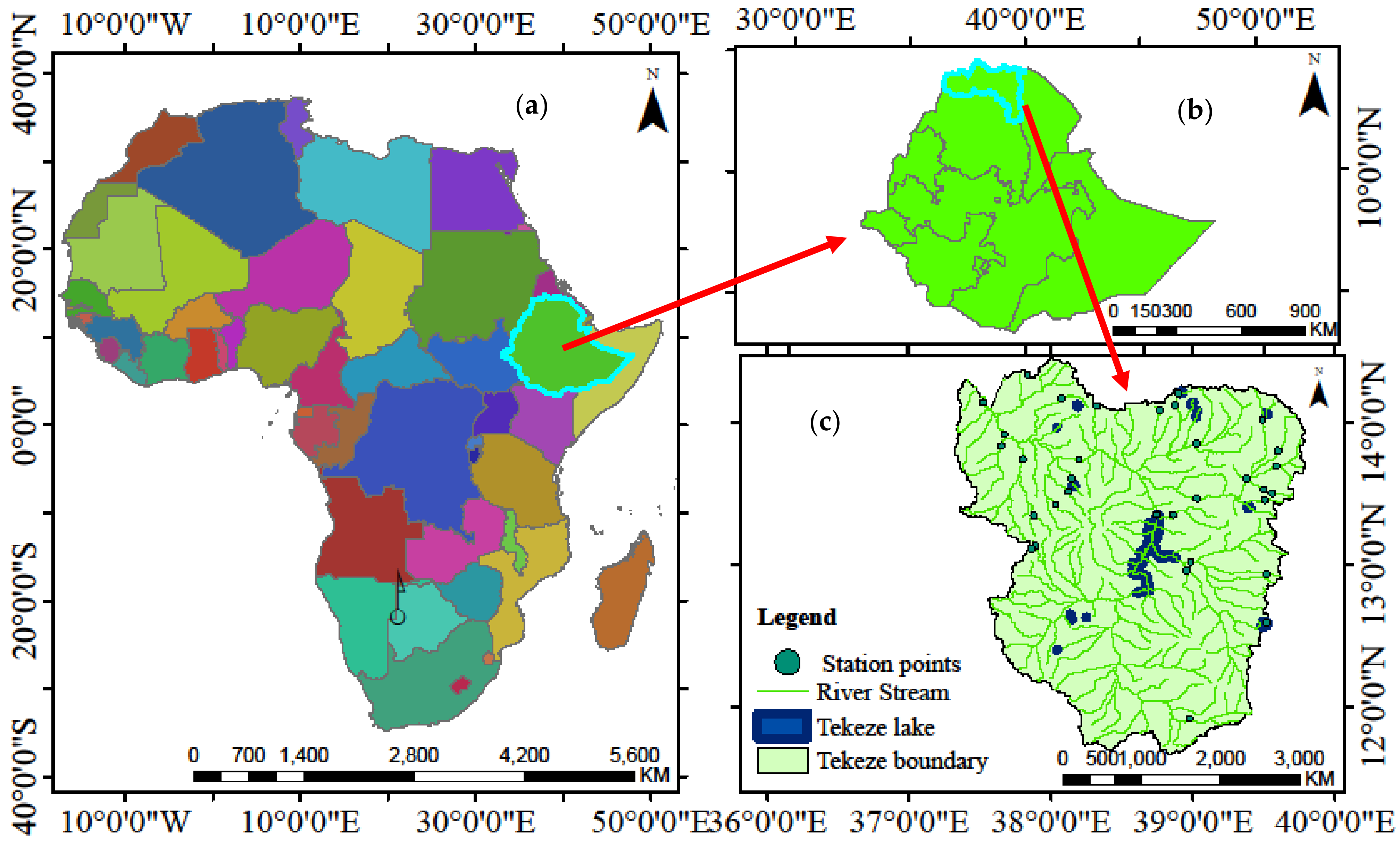
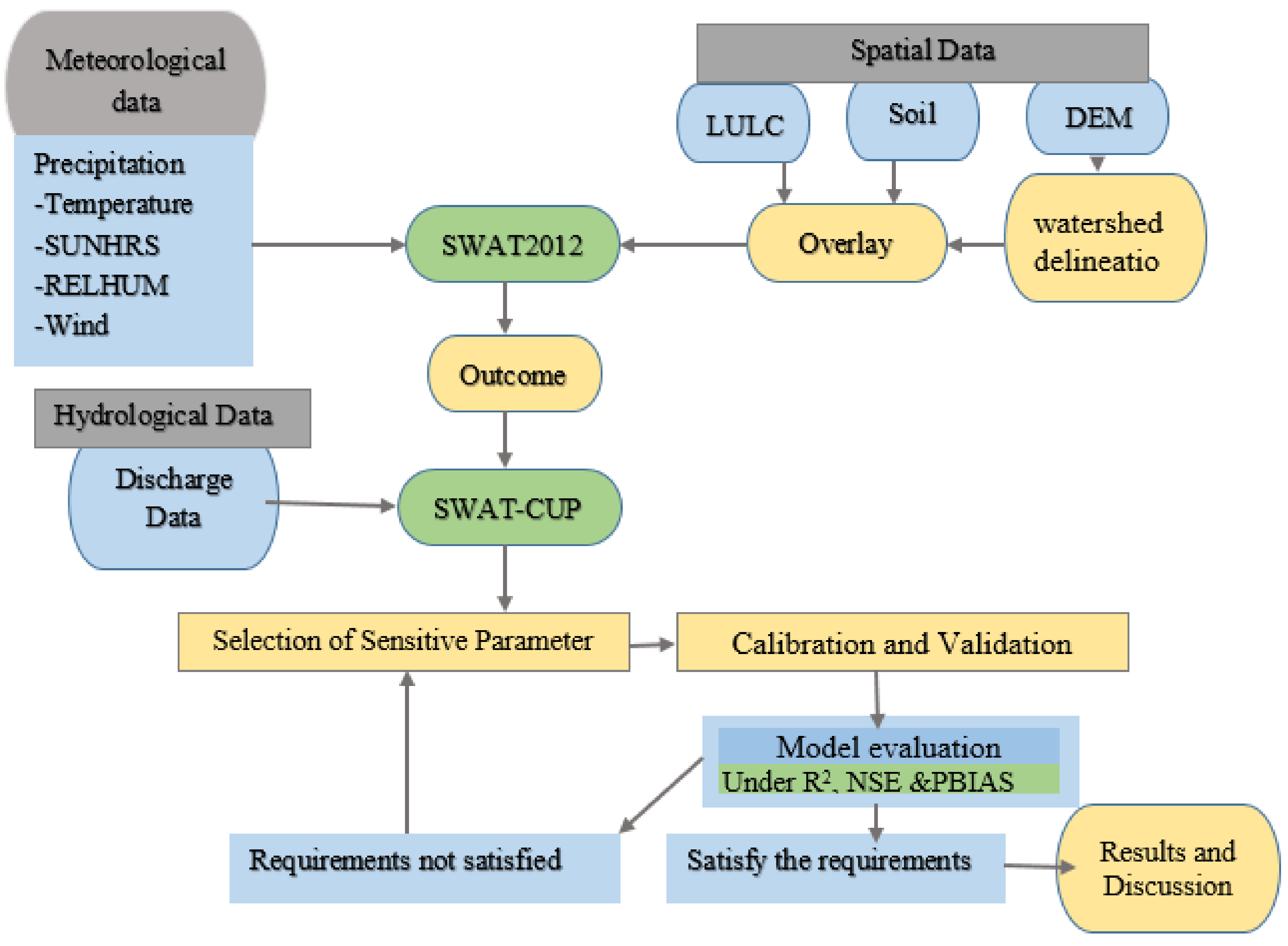

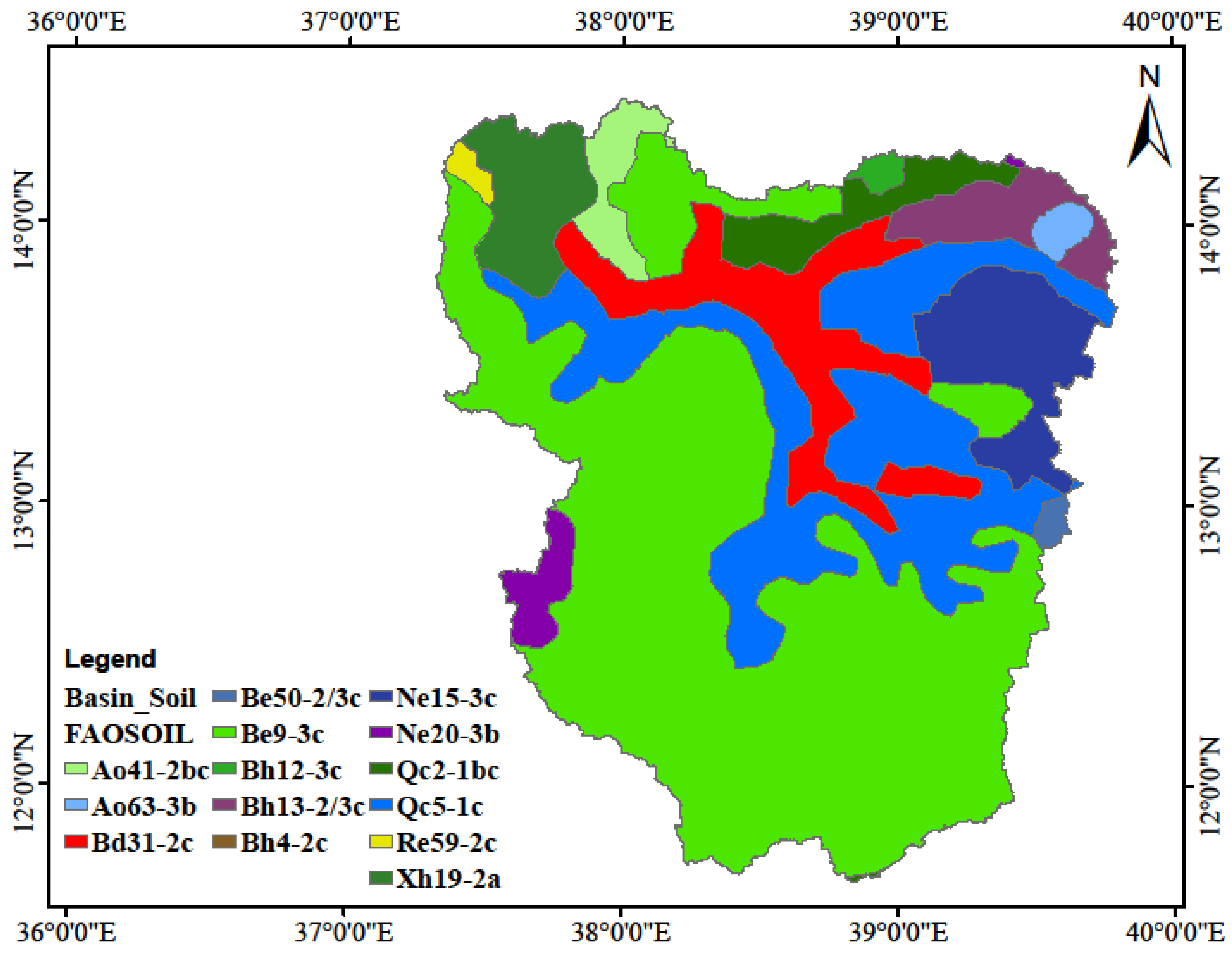
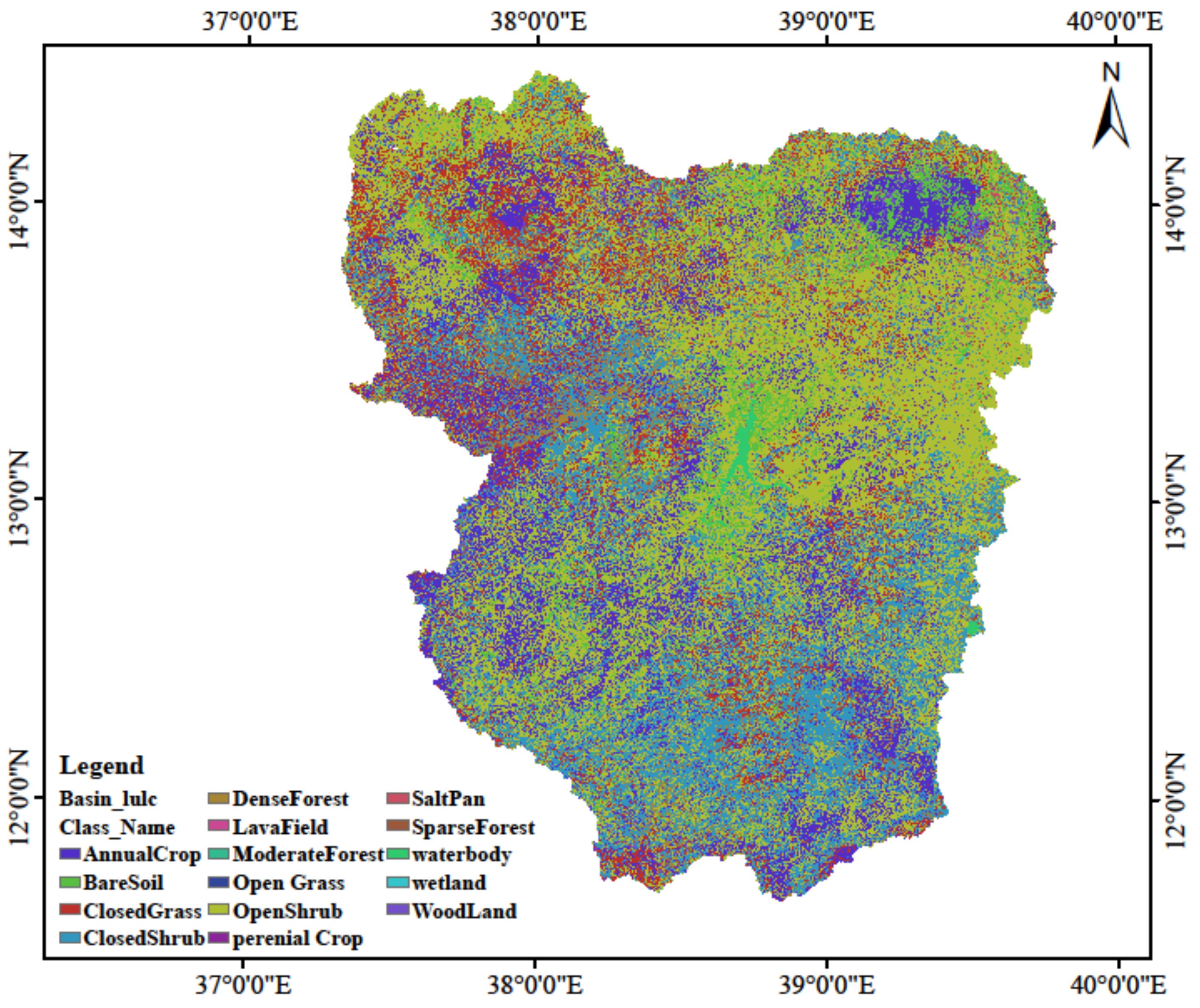



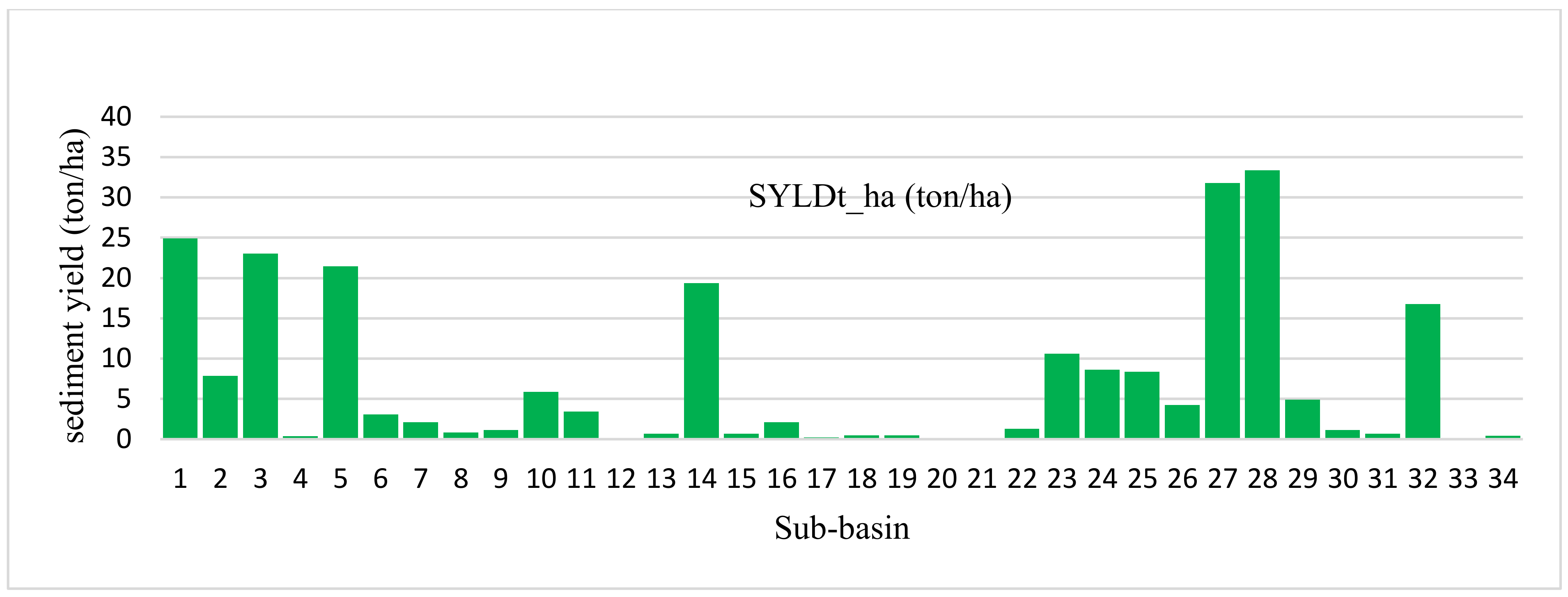
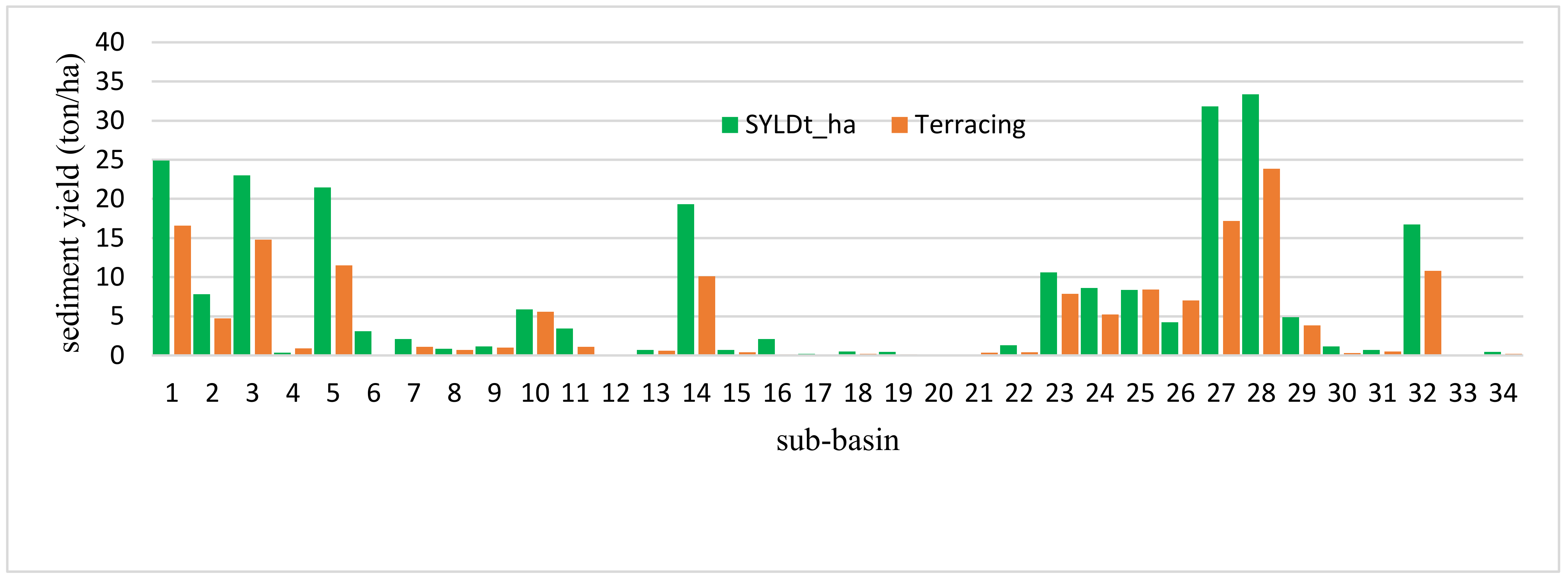
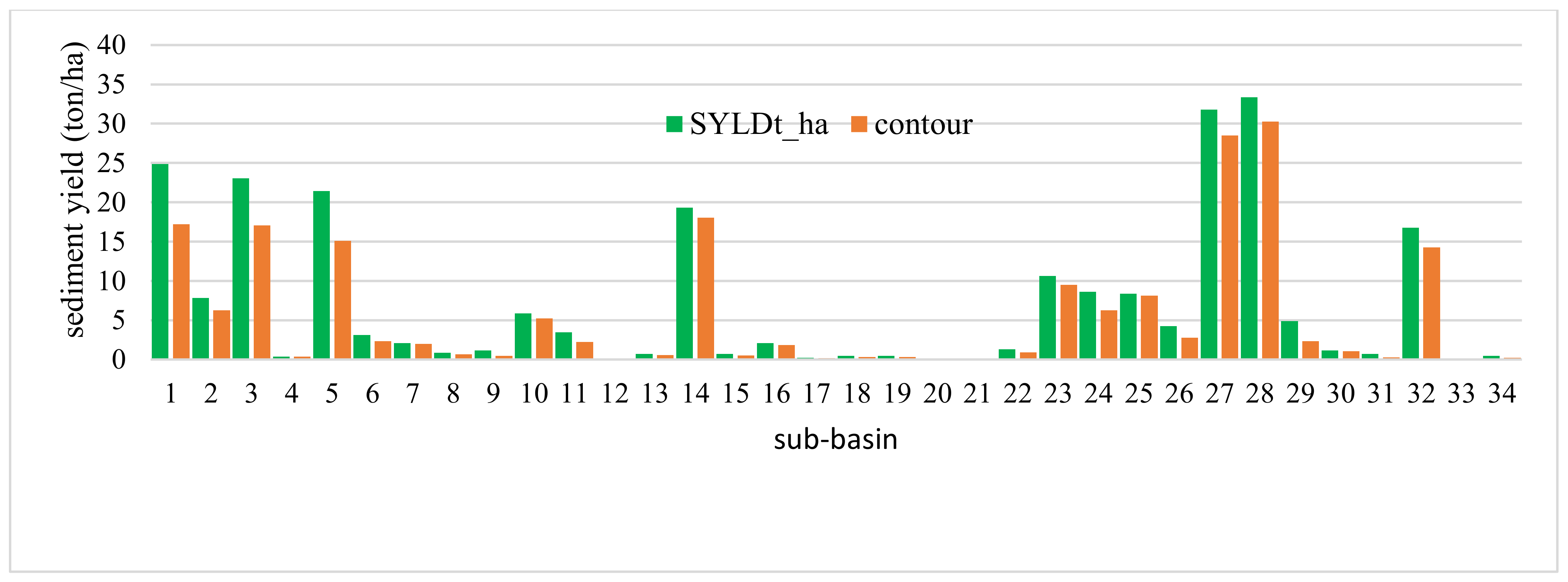

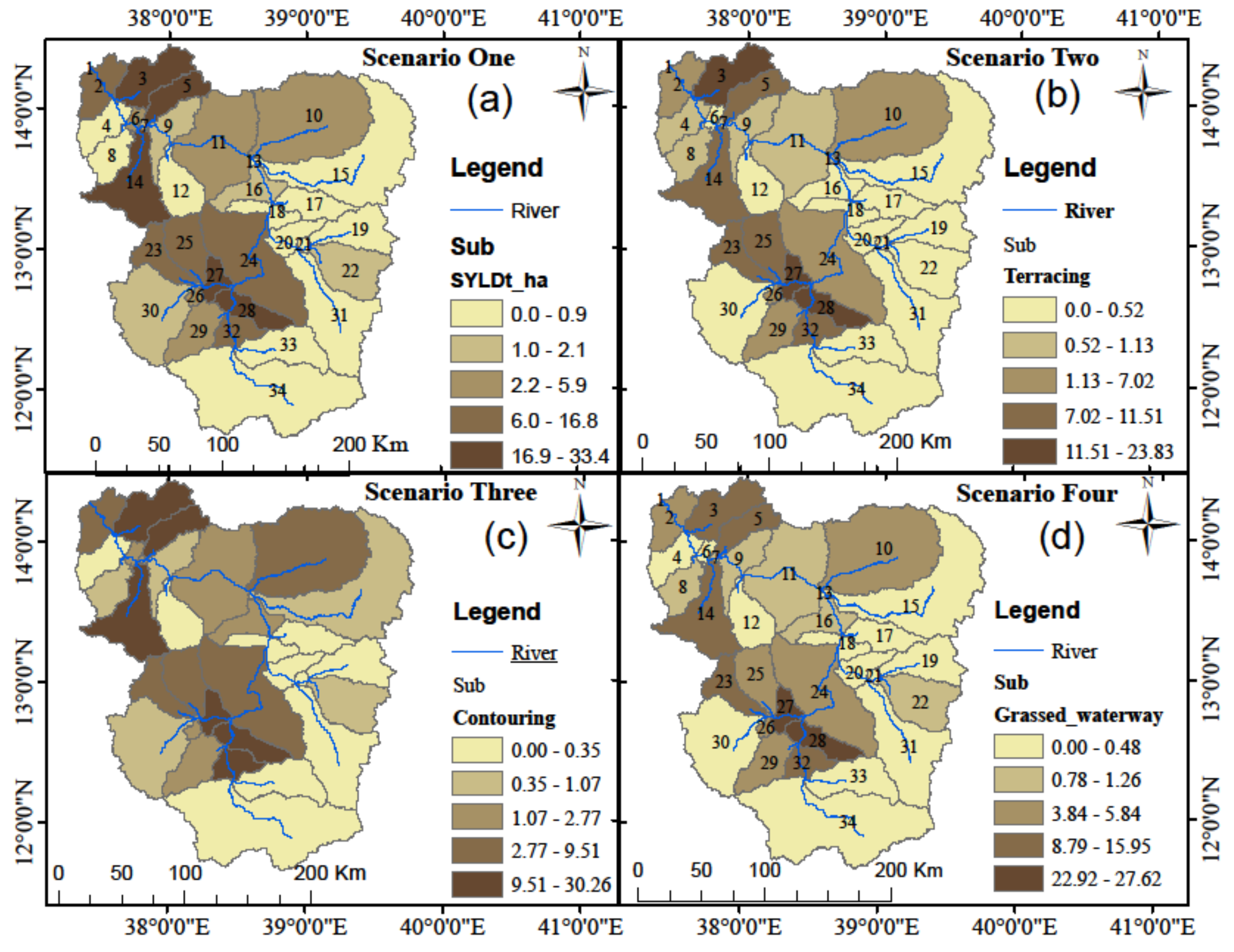
| Input Data | Description | Source | References |
|---|---|---|---|
| Meteorological data | Max and Min temperatures, solar radiation, wind speed, and relative humidity | Ethiopian National Meteorology Agency (ENMA) | [45,46] |
| Spatial data | DEM | https://earthexplorer.usgs.gov/ | [47,48] |
| LULC and Soil data | Ethiopia Ministry of Water, Irrigation, and Electricity (EMWIE), and additional image classification is performed using Erdas 2018. | [49,50] | |
| Hydrological data | Discharge and sediment data | Ethiopia Ministry of Water, Irrigation, and Electricity (EMWIE). | [49,50] |
| No. | Soil-Code | Soil-Texture Name | No. | Soil-Code | Soil-Texture Name |
|---|---|---|---|---|---|
| 1 | Ao41-2bc | Loam | 8 | Bh4-2c | Loam |
| 2 | Ao63-3b | Loam | 9 | Ne15-3c | Clay |
| 3 | Bd31-2c | Loam | 10 | Ne20-3b | Clay |
| 4 | Be50-2/3c | Clay-loam | 11 | Qc2-1bc | Sandy-loam |
| 5 | Be9-3c | Clay | 12 | Qc5-1c | Sandy-loam |
| 6 | Bh12-3c | Clay-loam | 13 | Re59-2c | Loam |
| 7 | Bh13-2/3c | Clay-loam | 14 | Xh19-2a | Clay-loam |
| Parameter | Description | p-Value | t-Stat | Fitted Values | Rank of Sensitivity |
|---|---|---|---|---|---|
| SOL-AWC | Soil water allowable capacity | 0.0 | −4.96 | 0.16 | 1 |
| ESCO.hru | Soil factor | 0.0 | 4.08 | 0.05 | 2 |
| SLSUBBSN.hru | Average slope length | 0.05 | 3.49 | 44.3 | 3 |
| SOL-BD | Soil bulk density | 0.55 | −3.47 | −0.02 | 4 |
| CN2.mgt | Curve number | 0.85 | 2.56 | 0.04 | 5 |
| GWQMN.gw | Groundwater level is needed for return flow to proceed | 0.56 | 0.56 | 2410 | 6 |
| SOL-K | Soil Hydraulic conductivity (mm/h) | 0.63 | 0.48 | −0.09 | 7 |
| GW-DELAY | Groundwater delay (day) | 0.78 | −0.29 | 88.7 | 8 |
| ALPHA-BF | Base-flow factor (day) | 0.81 | −0.25 | 0.38 | 9 |
| SUB | Grassed | Contour | Terracing | SUB | Grassed | Contour | Terracing |
|---|---|---|---|---|---|---|---|
| 1 | 1.97 | 7.66 | 8.32 | 18 | 0.166 | 0.166 | 0.28 |
| 2 | 2.81 | 1.61 | 3.09 | 19 | 0.265 | 0.118 | 0.29 |
| 3 | 7.08 | 5.95 | 8.26 | 20 | 0.051 | 0.057 | 0.06 |
| 4 | 0.135 | 0.03 | −0.53 | 21 | 0.048 | 0.02 | −0.21 |
| 5 | 8.62 | 6.33 | 9.94 | 22 | 0.223 | 0.39 | 0.87 |
| 6 | 2.96 | 0.76 | 2.98 | 23 | 1.82 | 1.1 | 2.74 |
| 7 | 0.88 | 0.09 | 1 | 24 | 2.769 | 2.37 | 3.39 |
| 8 | 0.064 | 0.193 | 0.15 | 25 | 2.97 | 0.23 | −0.06 |
| 9 | 0.28 | 0.67 | 0.12 | 26 | 0.42 | 1.488 | −2.76 |
| 10 | 1.71 | 0.63 | 0.3 | 27 | 8.755 | 3.28 | 14.61 |
| 11 | 2.19 | 1.22 | 2.32 | 28 | 5.734 | 3.1 | 9.53 |
| 12 | 0 | −0.04 | 0 | 29 | 0.604 | 2.57 | 1.06 |
| 13 | 0.322 | 0.14 | 0.1 | 30 | 0.811 | 0.07 | 0.85 |
| 14 | 5.224 | 1.3 | 9.24 | 31 | 0.212 | 0.41 | 0.17 |
| 15 | 0.226 | 0.18 | 0.28 | 32 | 4.86 | 2.5 | 5.93 |
| 16 | 0.925 | 0.26 | 1.95 | 33 | 0 | 0 | 0 |
| 17 | 0.0855 | 0.05 | 0.12 | 34 | 0.038 | 0.22 | 0.23 |
Disclaimer/Publisher’s Note: The statements, opinions and data contained in all publications are solely those of the individual author(s) and contributor(s) and not of MDPI and/or the editor(s). MDPI and/or the editor(s) disclaim responsibility for any injury to people or property resulting from any ideas, methods, instructions or products referred to in the content. |
© 2023 by the authors. Licensee MDPI, Basel, Switzerland. This article is an open access article distributed under the terms and conditions of the Creative Commons Attribution (CC BY) license (https://creativecommons.org/licenses/by/4.0/).
Share and Cite
Hailu, M.B.; Mishra, S.K.; Jain, S.K. Evaluation of Spatial-Temporal Variation of Soil Loss and Best Conservation Measures in an East Africa Catchment. Sustainability 2023, 15, 7778. https://doi.org/10.3390/su15107778
Hailu MB, Mishra SK, Jain SK. Evaluation of Spatial-Temporal Variation of Soil Loss and Best Conservation Measures in an East Africa Catchment. Sustainability. 2023; 15(10):7778. https://doi.org/10.3390/su15107778
Chicago/Turabian StyleHailu, Melese Baye, Surendra Kumar Mishra, and Sanjay K. Jain. 2023. "Evaluation of Spatial-Temporal Variation of Soil Loss and Best Conservation Measures in an East Africa Catchment" Sustainability 15, no. 10: 7778. https://doi.org/10.3390/su15107778
APA StyleHailu, M. B., Mishra, S. K., & Jain, S. K. (2023). Evaluation of Spatial-Temporal Variation of Soil Loss and Best Conservation Measures in an East Africa Catchment. Sustainability, 15(10), 7778. https://doi.org/10.3390/su15107778






